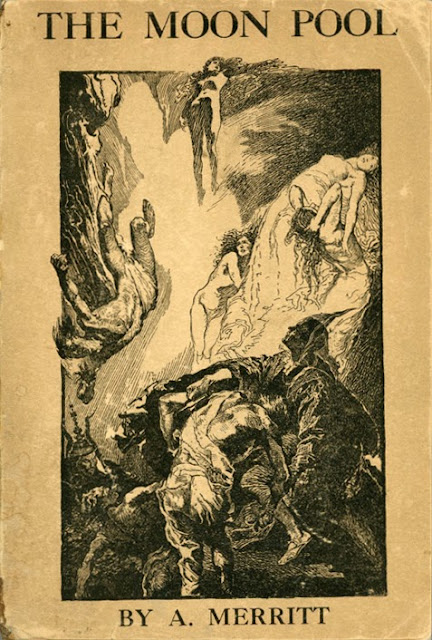I can see now that Francis Stevens had certain themes and ideas to which she returned again and again. You will find them in "Claimed!":
Dr. Vanaman is a physician, a man of science and reason. His explanations for the phenomena he encounters are material. "All material objects," he pontificates, "are subject to material law. That is axiomatic." Vanaman clings to that idea until it becomes entirely untenable. As before, Francis Stevens writes a kind of science fantasy in which she offers a scientific or materialistic way out for her readers, but it's clear that the reality in her stories is non-material, being either psychological, supernatural, spiritual, or some combination of the three. It's clear also that her sympathies lie there.
As a related theme, Francis Stevens was interested in altered states of consciousness (including drug-induced states that are absent in "Claimed!"). Here is a telling quote: "Since the moment when he [Vanaman] found himself left at the wharf, and his brain had cleared of that obsessing stupor, all the supernormal quality of the affair had seemed to grow steadily more questionable, fading to unreality like the uncertain memory of a dream--illusion--hallucination; three words that cover a multitude of otherwise inexplicable phenomena."
Even though she wrote for pulp magazines, Francis Stevens also wrote for a middle-class or upper middle-class readership. Her stories are mostly about that lifestyle--lawyers, doctors, politicians, big businessmen, big houses, servants, etc. Her low characters are pretty low, as in the sailor Jim Blair. A long time ago, I read a book called Mimesis by Erich Auerbach (1946). I understood very little of it and remember less, but I do remember that Auerbach made the point that the Bible is remarkable for being about ordinary people and their ordinary lives, whereas most of world literature was about kings and princes, warriors and heroes. That attention to the upper levels of society has come through even to the present day, although there has been more attention to the lower levels of society at least since the 1930s and '40s, for example in the Studs Lonigan trilogy by James T. Farrell (1932, 1934, 1935) and The Man with the Golden Arm by Nelson Algren (1949). I'll have more to say about that in my next interminable series, which involves William Gibson, Hugo Gernsback, Blade Runner, and a book called Trousered Apes, among other things.
The idea is that Francis Stevens invented dark fantasy. "Claimed!" is only further evidence that she did not. It's a somewhat darker story than its predecessors to be sure, and there is in fact a god in the story, a god "older than life" and beyond human comprehension. But here again, there is a difference between her gods and those created by H.P. Lovecraft for instance. Cthulhu is hostile to or indifferent towards human beings. We aren't really very important in his scheme of reconquering earth. He's kind of like the Vogons in A Hitchhiker's Guide to the Galaxy, who destroy our planet so as to construct an intergalactic highway. In contrast, humanity is central to the concerns of Francis Stevens' gods. In "Claimed!", the unnamed god who wants the green casket returned to him once loved the people of the ten scarlet cities and considered them his children. He bestowed upon them great power. In his own words:
"Thus the secret knowledge was kept by the ten kings, descendants of my first sons, who only had access to it. Till drinking too deep of power and ease and wealth, they grew drunken and presumptuous. Content no more to name themselves sons of a god, they forgot their mortality of flesh and believed themselves gods indeed.
"They disclaimed their debt of love. They turned against me and would have enslaved me also by the secret words of power I had taught them. Then I knew that I had done wrong, for men are small and foolish, not worthy of so great power nor fitted to wield it. In my anger I rocked the earth. It opened beneath their cities. The eternal fires were disturbed and burst forth from the mountains."
That's an old story, the story of Noah or Lot, biblical in its language, imagery, and theme. You might say that the green casket holds the fruit of the tree of the knowledge of good and evil (or the answer to the great question of life, the universe, and everything). Men are incapable of having that kind of power. That's why their god destroyed them in Atlantis and why he wants the casket returned to him now. Unlike Cthulhu, he is a god who loves--or loved--his people. He is not the indifferent or hostile god of dark fantasy, and he recognizes the goodness in the two future lovers and so stays his hand from destroying them. Cthulhu would do no such thing.
And those words strike me as an image of the world of today:
. . . drinking too deep of power and ease and wealth, they grew drunken and presumptuous. Content no more to name themselves sons of a god, they forgot their mortality of flesh and believed themselves gods indeed.
That pride earned them destruction. What will it earn us?
.jpg) |
| Claimed by Francis Stevens, with cover art by Gray Morrow, in the Avalon Books edition of 1966. |
Text and captions copyright 2015 Terence E. Hanley



















































